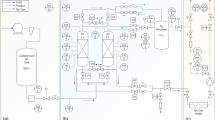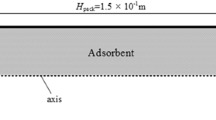Abstract
In a multi-bed pressure swing adsorption (PSA) process, cycle steps with gas flow transferring from one bed to another such as equalization, purge, etc. are generally practiced to enhance the product recovery. However, if the flows for the connected beds in these steps are not balanced, the PSA process may not operate in a symmetrical manner. In the modeling of the PSA process, most of the simulations consider only one bed and assume that the rest of the beds would behave in a same way. In order to assess the impact of bed symmetry on the PSA performance, a new PSA model capable of studying bed symmetry in a two-bed system is developed. Experimental results from this paper show that uneven equalization flow can result in a lower product purity and a peculiar purity curve at different equalization levels. This phenomenon can be successfully predicted by this model. Simulation results also show that in large-scale PSA units, asymmetrical operation can cause drastically different temperature profiles in different adsorbers and hence a much lower performance. This paper demonstrates the importance of maintaining operation symmetry in PSA processes.
Similar content being viewed by others
References
Chiang, A.S.T., "Arithmetic of PSA Process Scheduling," AIChE J., 11, 1910-1912 (1988).
Collins, J.J., "Air Separation by Adsorption," US Patent 3,973,931 (1976).
Doong, S.J. and R.T. Yang, "Hydrogen Purification by the Multibed Pressure Swing Adsorption Process," Reactive Polymers, 6, 7-13 (1987).
Kumar, R., V.G. Fox, D.G. Hartzog, R.E. Larson, Y.C. Chen, P.A. Houghton, and T. Naheiri, "A Versatile Process Simulator for Adsorptive Separation," Chem. Engr. Sci., 49(18), 3115-3125 (1994).
LaCava, A.I., J.A. Dominguez, and J. Cardenas, "Modeling and Simulation of Rate Induced PSA Separations," Adsorption: Science and Technology, A.E. Rodrigues, M.D. LeVan, and D. Tondeur (Eds.), NATO ASI Series, vol. 158, pp. 323-337, 1989.
Miller, G.W., K.S. Knaebel, and K.G. Ikels, "Equilibrium of Nitrogen, Oxygen, Argon, and Air in Molecular Sieve 5A," AIChE J., 33, 194-201 (1987).
Nakao, S. and M. Suzuki, "Mass Transfer Coefficient in Cyclic Adsorption and Desorption," J. Chem. Eng. Japan, 15, 114 (1983).
Ruthven, D.M., Principles of Adsorption and Adsorption Processes, Wiley, New York, 1984.
Ruthven, D.M., S. Farooq, and K.S. Knaebel, Pressure Swing Adsorption, VCH Publishers, New York, 1994.
Schaub, H.R., J. Smolarek, F.W. Leavitt, L.J. Toussaint, and K.A. LaSala, "Tuning of Vacuum Pressure Swing Adsorption Systems," US Patent 5,407,465 (1995).
Skarstrom, C.W., "Heatless Fractionation of Gases Over Solid Adsorbents," Recent Development in Separation Science, N.N. Li (Ed.), vol. 2, CRC Press, 1972.
Suzuki, M., Adsorption Engineering, Chemical Engineering Monographs 25, Tokyo and Elsevier Science Publishers, Kodansha, 1990.
Yang, R.T., Gas Separation by Adsorption Processes, Butterworths, Boston, 1987.
Author information
Authors and Affiliations
Rights and permissions
About this article
Cite this article
Doong, S.J., Propsner, P. Effect of Operation Symmetry on Pressure Swing Adsorption Process. Adsorption 4, 149–158 (1998). https://doi.org/10.1023/A:1008827218944
Issue Date:
DOI: https://doi.org/10.1023/A:1008827218944




